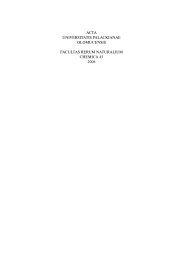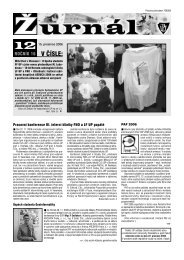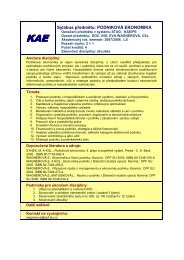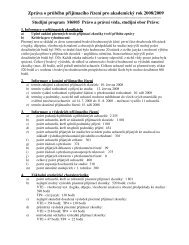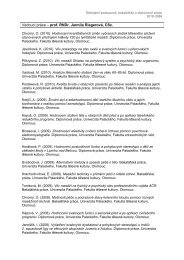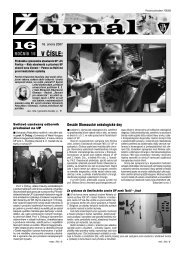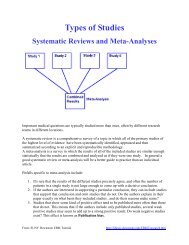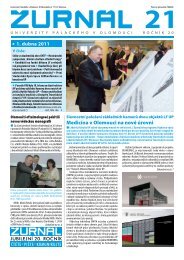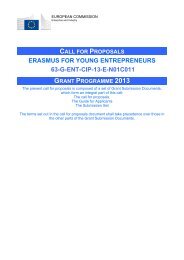44 Acta Univ. Palacki. Olomuc., Gymn. 2004, vol. 34, no. 2perspective of survival, minimal energy expenditure,synergism with other systems and in human beings, especiallyexpressively, from the viewpoint of realisationof functions directed by the cerebral cortex”.The maintenance of adequate metabolic levels dependingon actual bodily needs is necessary for survival.These actual functional needs of the body are cateredto by means of chemical and nervous regulation ofrespiration. In human beings, a sign of our superiorityover other animal species is the ability to perform, toa certain degree, the voluntary regulation of ventilation,or respiratory pattern, which has been developed overgenerations (Paleček, 1999). The voluntary regulation ofrespiratory patterns in humans takes place through:1. regulation of respiratory frequency;2. regulation of respiratory volume;3. regulation of the ratio of duration of inspirationand expiration;4. regulation of respiratory resistance;5. regulation of inspiratory and expiratory muscletone.Regulation of respiration is dependent on externalconditions and the functional status of the body, therebyinfluencing the dynamics of all of the above processes.By the term optimal respiratory pattern Ganong (1999)understands a respiratory pattern where the respiratoryeffort is minimal. According to Dylevský, Druga, andMrázková (2000) the respiratory cycle is directed underthe command of the respiratory centre in the oblongata.Inspiration is directed by a system of afferent and efferentconnections. Fibres of the vagus, fi bres of thephrenic nerve, fi bres of the spinal nerves innervatingthe inspiratory muscles, the spinal circuits and thesympathetic and parasympathetic fi bres innervatingthe bronchial muscles constitute the afferent part ofthe reflex arc.The ability to voluntarily regulate respiratory patternin humans is related not only to an autonomousregulation at the level of the oblongata and the brainstem, but also to a certain degree of mutual co-operationbetween the autonomous and cortical regulatory systems.According to Souček and Kára (2002) voluntaryregulation of respiratory pattern infl uences, throughautonomous regulation, among others, changes inblood pressure and heart rate by directly influencing therespiratory centre at the cardio and vasomotor centreslocated in the brain stem, especially in the oblongata.Apparently, information from receptors in the lung parenchymaand capillaries plays an important role in influencingautonomous regulation. According to Palečeket al. (1999) the cardiovascular system, to some extent,has corporate arterial baroreceptors in common withthe respiratory system. According to Souček and Kára(2002) it is by these means that the modulation of bloodpressure and heart rate through the direct influence ofthe respiratory centre on the cardio and vasomotor centresof the brain steam and oblongata occurs during thecourse of a respiratory cycle. This interaction modulatesalso the function of arterial and probably also low-pressurebaroreflexion. Periodical changes in blood pressureknown as the so-called Traube-Hering waves, which arerelated to autonomous regulation and partly influencedby respiration. Relationships between respiration andchanges in heart rhythm are mentioned in the study byGoldberger et al. (1984).Respiratory frequency and respiratory volume, respectivelyintensity of breathing, influence changes inthe actual functional activity of ANS. Changes in heartrate variability influenced by breathing during restingconditions known as the so called heart respiratory arrhythmia,thus express a relation among vagus activity,respiration and the modulation of heart rate. By observingthe changes in heart rate variability during spontaneousrespiration and during voluntary respiratory pattern,we can thus observe the relationship between respirationand actual changes in heart rate variability, respectivelychanges in the functional activity of the nervous system(Goldberger et al., 1994; Grosmann, 1992b; Katona &Jih, 1975; Malik, 1998).Mutual relations among respiration, functional activityof the autonomous nervous system and cortical regulationof respiration are empirically used, for instance, inthe Indian practise of respiratory exercises (pranajama).This part of so-called hathayoga is regarded traditionallyto be the most important component of yoga exercises(Dostálek, 1996). In Western culture, respiratory gymnasticsoriginated from a yoga-type respiration used forhealing of ventilation disorders.The influence of some yoga respiratory techniqueson changes in lung ventilation was studied in the pastand duly published in the papers by Frostel, Pande, andHedenstierna (1983), Gore and Gharote (1987), andMiles (1964). Frostel, Pande, and Hedenstierna (1983)state that during rapid diaphragmatic respiration, withthe so-called technique of kapalabhaty which we usedas one of the yoga techniques in our research, changesin blood gas concentration do not occur. Raghujah andTelles (2003) describe the influence of supported respirationthrough one nostril on changes in ANS activity.Some auto concentration techniques using the effectof respiratory techniques and their influence on changesin cerebral cortex activity were described in studies byDostálek and Krása (1976), Fabián, Lepičovská, andDostálek (1982), Lepičovská and Dostálek (1981),Meyer and Gotoh (1960).The influence of respiration on blood pressure decreasewas described in the works of Patel (1978). Inthe works of Ornish (1991) the complex effect of yogaexercise is described and the practise of breathing onpositive changes in stenosal coronary vessels section
Acta Univ. Palacki. Olomuc., Gymn. 2004, vol. 34, no. 2 45in patients with ischemic heart disorder played animportant role. The use of spectral analysis of heartrate variability when assessing the effect of respiratorytechniques on the functional changes in the autonomousnervous system was studied in a thesis by Ježek (2001).The influence of regulated and spontaneous respirationon actual changes in the autonomous nervous system,respectively on the frequency and amplitude modulationof the respiratory bound activity of the vagus, was studiedin the works of Kolisko, Salinger et al. (1997, 2001).Additionally, Brown et al. (1993), Grosmann, Beek, andWietjes (1990), Saul, Kaplan, and Kitney (1988) studiedthe relation among respiration frequency, heart rate oscillationand respectively, the R-R intervals.Some special respiratory techniques (hyperventilationetc.) are used in some special psychotherapeutictechniques (for example holotropic respiration). In thesphere of psychotherapy the effect of regulated intensifiedrespiration is known to induce intensified relaxationresponses in the body (Baštecký, Šavlík, & Šimek, 1993;Benson & Starková, 1997; Míček, 1984).Voluntary regulation of respiration is thus regardedby us as a fundamental factor that aims to infl uence,through actual autonomous regulation, the activity of itspartial subsystems in sympathetic and parasympatheticaspects while systematically influencing the body’s activitydirected by this system. That’s why, since 1995, wehave been engaged in the study of the problem and thepossibilities of objectifying the voluntary regulation ofthe actual functional condition of ANS with the methodof spectral analysis of heart rate variability (Kolisko,Salinger, Opavský et al., 1997).The Vario Cardio TF4 diagnostic system used byus for assessing R-R intervals variability enables us,together with the method of spectral analysis of heartrate variability (Yamamoto & Hughson, 1991; Havano,Sakakibara, Yamada et al., 1991; Salinger, Vychodil,Novotný et al., 1995; Salinger, Pumpla, Vychodil et al.,1999), to observe non-invasively the actual functionalchanges in heart rate variability that reflect actual functionalchanges in regulation modulated by the autonomousnervous system.The method of spectral analysis of heart rate variabilityenables the observation of the relationship betweenselected respiratory techniques and actual functionalchanges in heart rate variability.The current literature does not offer detailedstudies on the relations between voluntary regulationof respiration and changes in heart rate variability,respectively frequency and amplitude modulation ofthe frequency spectrum characterising sympatheticand vagus activities. The problems of the relationshipbetween respiratory frequency and changes in heartrhythm is described in the works of Brown, Beightol,Koh, and Eckberk (1993), Grossman (1992a, 1992b),Grossman, Karemaker, and Wieling (1991), Grossmanand Kollai (1993). Saul et al. (1988, 1989) found a relationshipbetween respiratory frequency and respiratorysinus arrhythmia. The occurrence of respiratorysinus arrhythmia is closely related to vagus activation.In a number of published works there is a descriptionof a marked decrease or a complete absence of respiratorysinus arrhythmia during cholinergic blockage orafter vagotomy (Cacioppo et al., 1994; Katona & Jih,1975; Kollai & Mizsci, 1990). For this reason we supposethat regulation of respiration has an extraordinaryimportance during activation of the vagus componentof the autonomous nervous system and enables actualregulation of the sympathetic-vagus balance (Akselrodet al., 1981, 1985).Intentionally, apart from Šlachta, Stejskal, Elfmarket al. (2002) and Stejskal, Šlachta, Elfmark et al. (2002),we did not apply the total autonomous regulation levelparameter, so-called functional age, which expressesbasically the functional changes in sympathetic andparasympathetic activities depending on the verticaland horizontal body position during examination.In our study, we opted for the sitting position with anupright trunk for assessing the influence of respirationon changes in SAHRV. This position is connected withchanges of diaphragm position and enables a highereffectiveness of respiratory muscles engagement (Véle,1997; Paleček et al., 1999). That’s why it is evidentlyempirically applied and duly recommended for respiratoryand auto concentration exercises in yoga (Dostálek,1996).RESEARCH AIMTo find changes in heart rate variability, respectivelychanges in the autonomous nervous system during differentbreathing techniques.RESEARCH QUESTIONS AND HYPOTHESES1. What is the relationship between frequency of respirationand the frequency component of ANS bound torespiration which we regard as vagus activity?2. In what manner do the values of the observed functionalparameters of the spectral analysis of heart ratevariability (SAHRV) change in frequency zones of verylow frequency (VLF), low frequency (LF) and high frequency(HF) during rhythmised respiratory frequencyof 12 cycles/min., during spontaneous respiratoryfrequency, during intensified respiration (so-called fullyoga breath), during alternate respiration through onenostril and during rhythmised tachypnoe (the so-calledtechnique of kapalabhaty)?
- Page 1 and 2: ACTAUNIVERSITATIS PALACKIANAE OLOMU
- Page 3 and 4: ACTAUNIVERSITATIS PALACKIANAE OLOMU
- Page 5: Acta Univ. Palacki. Olomuc., Gymn.
- Page 8 and 9: 8 Acta Univ. Palacki. Olomuc., Gymn
- Page 10 and 11: 10 Acta Univ. Palacki. Olomuc., Gym
- Page 12 and 13: 12 Acta Univ. Palacki. Olomuc., Gym
- Page 14: 14 Acta Univ. Palacki. Olomuc., Gym
- Page 17: Acta Univ. Palacki. Olomuc., Gymn.
- Page 20 and 21: 20 Acta Univ. Palacki. Olomuc., Gym
- Page 22: 22 Acta Univ. Palacki. Olomuc., Gym
- Page 26 and 27: 26 Acta Univ. Palacki. Olomuc., Gym
- Page 28 and 29: 28 Acta Univ. Palacki. Olomuc., Gym
- Page 32 and 33: 32 Acta Univ. Palacki. Olomuc., Gym
- Page 34 and 35: 34 Acta Univ. Palacki. Olomuc., Gym
- Page 36 and 37: 36 Acta Univ. Palacki. Olomuc., Gym
- Page 38 and 39: 38 Acta Univ. Palacki. Olomuc., Gym
- Page 40 and 41: 40 Acta Univ. Palacki. Olomuc., Gym
- Page 43: Acta Univ. Palacki. Olomuc., Gymn.
- Page 47 and 48: Acta Univ. Palacki. Olomuc., Gymn.
- Page 49 and 50: Acta Univ. Palacki. Olomuc., Gymn.
- Page 51 and 52: Acta Univ. Palacki. Olomuc., Gymn.
- Page 53 and 54: Acta Univ. Palacki. Olomuc., Gymn.
- Page 55 and 56: Acta Univ. Palacki. Olomuc., Gymn.
- Page 57 and 58: Acta Univ. Palacki. Olomuc., Gymn.
- Page 59: Acta Univ. Palacki. Olomuc., Gymn.
- Page 62 and 63: 62 Acta Univ. Palacki. Olomuc., Gym
- Page 64 and 65: 64 Acta Univ. Palacki. Olomuc., Gym
- Page 66 and 67: 66 Acta Univ. Palacki. Olomuc., Gym
- Page 68 and 69: 68 Acta Univ. Palacki. Olomuc., Gym
- Page 70 and 71: 70 Acta Univ. Palacki. Olomuc., Gym
- Page 72 and 73: 72 Acta Univ. Palacki. Olomuc., Gym
- Page 74 and 75: 74 Acta Univ. Palacki. Olomuc., Gym
- Page 76 and 77: 76 Acta Univ. Palacki. Olomuc., Gym
- Page 78 and 79: ACTAUNIVERSITATIS PALACKIANAE OLOMU



